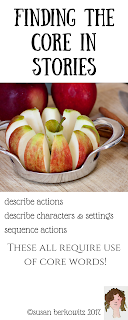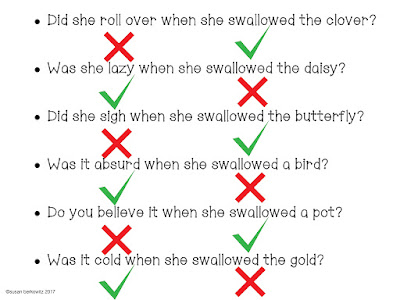If you read this blog consistently - or even occasionally - you will know that I write a lot about using core words with AAC users, and that I also write a lot about literacy instruction and story-based language intervention.
When I worked in a school system with students with severe language disorders, I used storybooks almost exclusively in my interventions. I developed an entire “curriculum” of language skills around books and short stories; developing story grammar, syntax, and other “form” skills, but also teaching about point of view, characterization, and other broader skills.
With AAC users, however, I most often use stories to develop their language skills while still instructing in how to access their AAC systems to find the words they need.
I know St. Patrick’s day is long behind us, but I want to use a storybook I’ve worked with for using core words. The book is, “I Know an Old Lady Who Swallowed a Clover,” by Lucille Colandro.
This book is not good for teaching story grammar, in so far as it does not actually contain an episode, or a critical thinking triangle, as Moreau terms the relationship between the event, the character’s feelings about the event, and his developing a plan.
Rather, this type of story provides a series of actions and, usually, an ending that has a consequence or ending action. A repetitive line in these stories can be used for an AAC user to participate in the reading, even if his participation is limited to doing so with a pre-recorded message.
However, as we focus on using core words in every day activities, reading is a great place to talk about key words. In this story, we can focus on “not” in multiple opportunities (“She did not roll over,” etc.). AAC users need to find both the “not” symbol and the action symbol in their systems in order to respond to the story.
And these stories are wonderful for teaching sequencing. They are, basically, a series of related events by a single character, done in order. Looked at another way, the stories are a series of First - Then statements, which many students can grasp.
And, in talking about the events, AAC users must be able to find the action words in their systems. In this case, words like; roll, swallow, sigh, glide, carry, and dance. Also, describing words need to be found; such as absurd (or a synonym), lazy, bright, shiny, and cold.
Choose your books for interest, for reading level, and - for your AAC users - for their ability to highlight core words.
Have fun, and…..keep on talking!





No comments
Post a Comment